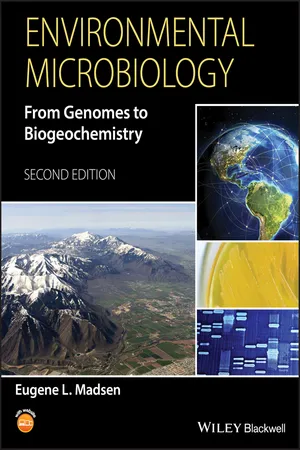
Environmental Microbiology
From Genomes to Biogeochemistry
Eugene L. Madsen
- English
- ePUB (apto para móviles)
- Disponible en iOS y Android
Environmental Microbiology
From Genomes to Biogeochemistry
Eugene L. Madsen
Información del libro
New and expanded for its second edition, Environmental Microbiology: From Genomes to Biogeochemistry ¸ Second Edition, is a timely update to a classic text filled with ideas, connections, and concepts that advance an in-depth understanding of this growing segment of microbiology. Core principles are highlighted with an emphasis on the logic of the science and new methods-driven discoveries. Numerous up-to-date examples and applications boxes provide tangible reinforcement of material covered. Study questions at the end of each chapter require students to utilize analytical and quantitative approaches, to define and defend arguments, and to apply microbiological paradigms to their personal interests. Essay assignments and related readings stimulate student inquiry and serve as focal points for teachers to launch classroom discussions. A companion website with downloadable artwork and answers to study questions is also available.
Environmental Microbiology: From Genomes to Biogeochemistry, Second Edition, offers a coherent and comprehensive treatment of this dynamic, emerging field, building bridges between basic biology, evolution, genomics, ecology, biotechnology, climate change, and the environmental sciences.
Preguntas frecuentes
Información
1
Significance, History, and Challenges of Environmental Microbiology
Chapter 1 Outline
- 1.1 Core concepts can unify environmental microbiology
- 1.2 Synopsis of the significance of environmental microbiology
- 1.3 A brief history of environmental microbiology
- 1.4 Complexity of our world
- 1.5 Many disciplines and their integration
1.1 Core concepts can unify environmental microbiology
- Core concept 1. Environmental microbiology is like a child’s picture of a house – it has (at least) five sides (a floor, two vertical sides, and two sloping roof pieces). The floor is evolution. The walls are thermodynamics and habitat diversity. The roof pieces are ecology and physiology. To learn environmental microbiology we must master and unite all sides of the house.
- Core concept 2. The prime directive for microbial life is survival, maintenance, generation of adenosine triphosphate (ATP), and sporadic growth (generation of new cells). To predict and understand microbial processes in real-world waters, soils, sediments, and other habitats, it is helpful to keep the prime directive in mind.
- Core concept 3. There is a mechanistic series of linkages between our planet’s habitat diversity and what is recorded in the genomes of microorganisms found in the world today. Diversity in habitats is synonymous with diversity in selective pressures and resources. When operated upon by forces of evolution, the result is molecular, metabolic, and physiological diversity found in extant microorganisms and recorded in their genomes.
- Core concept 4. Advancements in environmental microbiology depend upon convergent lines of independent evidence using many measurement procedures. These include microscopy, biomarkers, model cultivated microorganisms, molecular biology, and genomic techniques applied to laboratory- and field-based investigations.
- Core concept 5. Environmental microbiology is a dynamic, methods-limited discipline. Each methodology used by environmental microbiologists has its own set of strengths, weaknesses, and potential artifacts. As new methodologies deliver new types of information to environmental microbiology, practitioners need a sound foundation that affords interpretation of the meaning and place of the incoming discoveries.